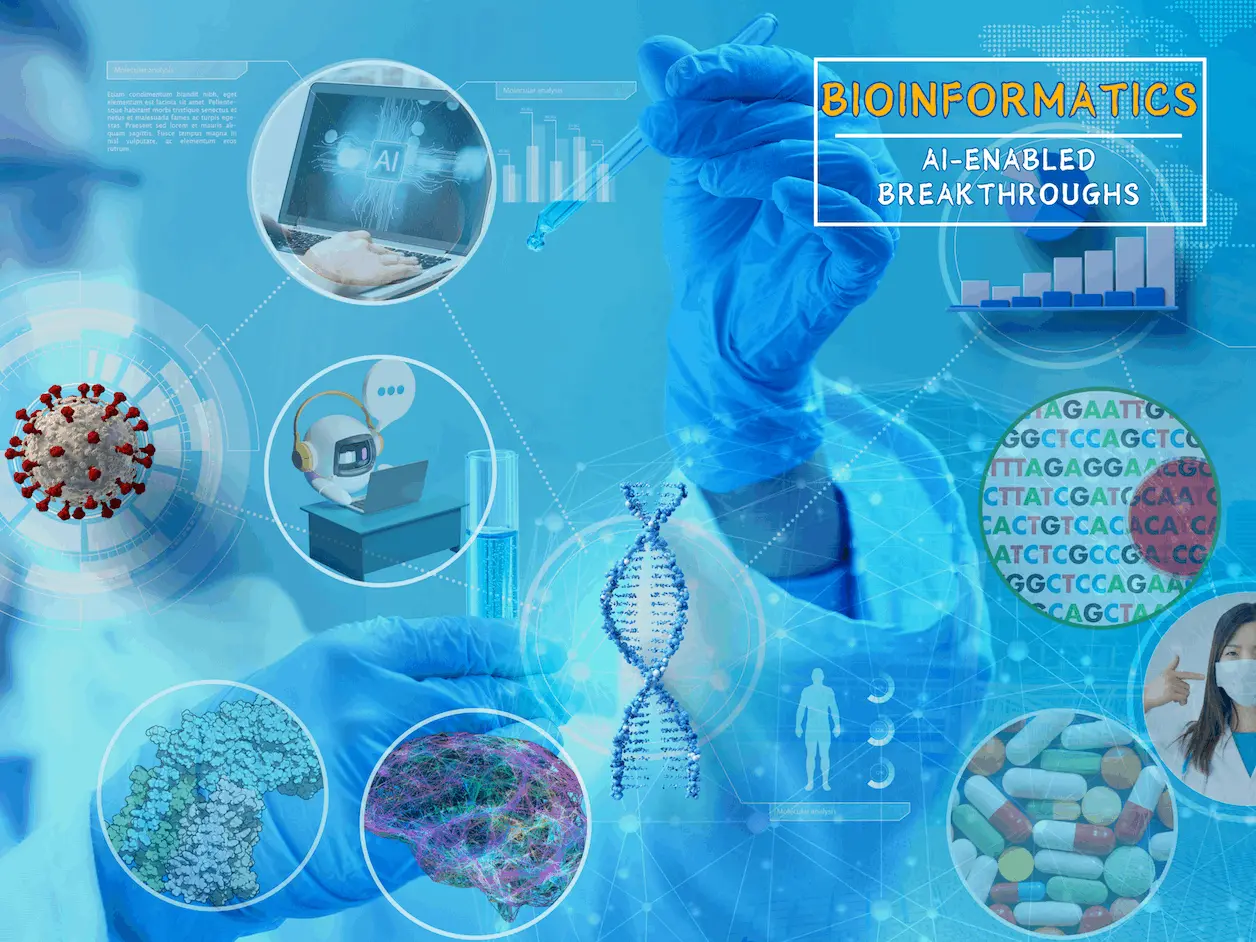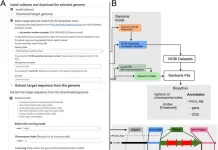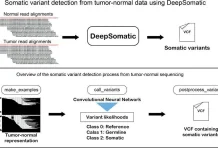The field of bioinformatics is experiencing a renaissance fueled by Artificial Intelligence (AI). Techniques like deep learning and machine learning can handle complex biological problems with an unmatched power that was previously unimaginable, leading to new scientific breakthroughs. Scientific discoveries are accelerated while openings for advances into other realms, such as agriculture and medicine, are created due to such increased abilities. In this blog post, we’ll delve deeper into the top 10 breakthroughs enabled by AI in Bioinformatics that demonstrate its revolutionary potential, highlighting the specific tools and algorithms driving these advancements.
#1 Protein Structure Prediction
DeepMind created AlphaFold, an AI system that predicts protein structures based on their amino acid sequence. This difficulty persisted in bioinformatics for many years. The high accuracy of AlphaFold allows researchers to know how protein works and design medicines quickly. Its availability at no cost makes it useful in fighting diseases such as malaria and cancer. This AI tool is a game-changer in bioinformatics that promises to reshape our comprehension of the nature of life.
#2 AI in Drug Discovery and Design
The landscape of drug discovery is undergoing a revolution with breakthroughs like AlphaFold and AIDDISON™. Traditionally, this has been a slow and costly bottleneck in determining protein structures crucial for drug designs. This is where AlphaFold steps up as the best solution. AI-powered AlphaFold 2 gives precise predictions concerning protein structure, while AlphaFold 3, released recently, is capable of predicting structures and interactions of all biomolecules. In this regard, molecular studies allow scientists to observe how potential antiviral molecules interact with these proteins on atomic scales. Amino acids are known to have side chains that differentiate the various types.
The AIDDISON™ drug discovery software combines artificial intelligence, machine learning, and computer-aided drug design (CADD) methods in one toolkit that can be useful for medicinal chemistry purposes. Also, as an integrated platform for both structure-based and ligand-based approaches to drug designing, it includes all aspects of virtual screening and has tools for lead optimization and discovery.
#3 Revealing Disease
Companies like GRAIL and Freenome are helping in the fight against cancer through early detection. GRAIL’s Galleri test is a simple blood draw that can detect signals of more than 50 types of cancers, most of which have no recommended screenings. The multi-cancer early detection (MCED) approach enables intervention before symptoms appear. On the other hand, Freenome applies a multi-omics approach by testing various biological molecules present in the blood to identify early cancer signs. They use their AI-powered platform to look for patterns that could indicate cancer in this data. In its turn, this represents a paradigm shift from either company’s perspective when it comes to early detection; it is a promise of a future where cancers will be diagnosed at their most treatable stages.
#4 Genome Assembly and Annotation
AI tools are revolutionizing genome assembly by accurately piecing together DNA fragments and identifying functional elements within genomes. MaSuRCA and Enformer help in understanding genomes while performing different tasks. MaSuRCA belongs to the class of genome assemblers. It takes small DNA reads and constructs a complete genome sequence as if solving a jigsaw puzzle. Enformer, however, is concerned with annotating the assembled genome. This tool looks at the DNA code to predict how the genes are expressed, that is, it assesses how instructions written in DNA lead to proteins being made. Enformer draws inspiration from transformers’ processing of language and considers long-range interactions within the DNA, which is equivalent to how distant words can impact the meaning of a sentence. Enformer predicts how genetic variations may change individual genes, resulting in diseases.
#5 Metagenomics Analysis
The study of microbial genomes across the environmental microbiome is called metagenomics. MEGAN and QIIME 2 AI have revolutionized the field of metagenomics by helping researchers deal with massive volumes of sequencing data. MEGAN Community Edition (CE)supports the exploration and understanding of processed microbiome data, while QIIME2 offers an extensive toolkit for analyzing from scratch. By doing so they allow scientists to delve into this amazing world of microbes. This information will help scientists to understand the composition and activities of microorganisms in various ecosystems.
#6 Personalized Medicine
In precision medicine, NVIDIA Clara is a software suite that speeds up genomic analysis. Clara reduces the time taken in analysis significantly by utilizing GPUs, hence allowing doctors and scientists to reveal the genetic information of their patients swiftly. Consequently, this leads to faster diagnosis, personalized care procedures, and efficient drug discovery. For affordability and speed in short-read analysis, in-depth structural variant detection in long-read analysis, and a holistic insight into individual cells through single-cell analysis, Clara has tools for various sequencing types. In conclusion, healthcare providers can provide more accurate and effective treatments with the aid of NVIDIA Clara, thereby creating an opportunity for personalized medicines.
#7 Prediction of Non-Coding RNA Functions
The role played by artificial intelligence in predicting ncRNA functions is very important. Rfam houses an array of RNA families and provides well-known alignments and structures for a myriad of ncRNAs. Infernal, software powered by AI, uses these Rfam profiles to search through DNA sequences. Consequently, Infernal can detect probable ncRNA homologs within any given DNA information with a combination of sequence similarity together with RNA structure conservation using covariance models (CMs). This helps researchers predict the function of unknown ncRNAs that have similar family inferences within Rfam. It is through this combination of Rfam and Infernal that AI comes to the rescue in answering questions about this vast group of molecules that engage various regulatory processes in cells.
#8 Large-Scale Datasets Functional Annotation
While Expensive and slow experiments used to be the only way to determine protein functions. AlphaFold and ESMFold are revolutionizing the functional annotation of large protein datasets. These AI models enable the prediction of protein structures from sequences of amino acids, thereby making the process much faster. By resorting to external databases for higher accuracy, AlphaFold distinguishes itself from ESMFold, which values speed as ensured by language models.
This structural knowledge leads to DeepProSite, an approach that uncovers binding sites and unlocks proteins’ roles. Unlike existing approaches, DeepProSite combines structure (from AlphaFold/ESMFold) and sequence information (via language models). This helps make better predictions, especially for unbound structures, which was a difficult task for previous methods. To this end, DeepProSite is highly versatile for various compounds, such that it can be utilized in large-scale annotation of protein functions, thus heralding new insights into drug discovery in other fields.
#9 Crop Improvement Towards Sustainable Agriculture
Bayer exploits modern technological breakthroughs like artificial intelligence and gene editing within its Precision Breeding program to deliver better crops. However, the company may require knowledge of global strategy and implementation for a successful operation. This is where Plant Location International (PLI), an IBM specialized consulting division, comes into play. The seventy-year-old experience of PLI can be instrumental for Bayer in tackling worldwide agricultural environments. For instance, PLI will help Bayer identify appropriate sites for planting these new varieties by considering factors such as climate, soil conditions, and regulations. This helps to ensure that Bayer’s innovations enhance crop yields while also being flexible and sustainable across diverse farming regions, which guarantees food security as well as prudent cultivation practices in the future.
#10 Drug Target Identification
In the race to identify new drug targets is increasingly being driven by AI. Drug discovery is now revolutionizing with AI-powered platforms, such as PHARMA.AI by Insilico Medicine and Benevolent Platform by BenevolentAI. Both employ large-volume datasets and machine-learning algorithms to discover new drug targets. PHARMA.AI has included tools such as PandaOmics, which performs multi-omics analysis to locate promising targets for specified diseases. Conversely, the approach of BenevolentAI’s platform is wider in scope since it utilizes an extensive biomedical data landscape to spot linkages across various diseases. This multidimensional analysis can identify potential targets that would have been omitted if conventional methods had been employed. The purpose of both companies applying these AI-driven approaches is to hasten the process of discovering drugs, thus improving patient treatment.
Conclusion
AI’s impact on bioinformatics has only begun, but it is evolving fast. As AI algorithms get more intelligent, we will have more breakthroughs while datasets grow exponentially over the years. It may be used in numerous aspects where such spheres as these are touched upon by AI with transformation at hand.
- Gene Editing: With CRISPR gene editing techniques adopting AI-powered tools, there might arise opportunities for novel gene therapies for different diseases that need precise and efficient solutions when curing them.
- Biomarker Discovery: Complex dataset analysis using artificial intelligence can help identify new biomarkers for disease diagnosis, prognosis, and treatment response.
- Medical Imaging Analysis: This has proved extremely useful because, most of the time, with the assistance of AI algorithms, there is a high probability of a very accurate early diagnosis.
However, this is not to say that bioinformatics and AI will be two separate things altogether. Through the careful and collaborative utilization of AI, we can open up a new era where science has intensified, bringing about breakthroughs in health, farming, and living things.
Note: This is a list of some of the most exciting bioinformatics discoveries, this is not a ranking article.
Join the Conversation!
How do you feel about the remarkable advancements in artificial intelligence in bioinformatics? How do you think AI will disrupt your areas of bioinformatics?
Follow Us!
Learn More:
Anchal is a consulting scientific writing intern at CBIRT with a passion for bioinformatics and its miracles. She is pursuing an MTech in Bioinformatics from Delhi Technological University, Delhi. Through engaging prose, she invites readers to explore the captivating world of bioinformatics, showcasing its groundbreaking contributions to understanding the mysteries of life. Besides science, she enjoys reading and painting.

















Interesting and exciting
Hey people!!!!!
Good mood and good luck to everyone!!!!!